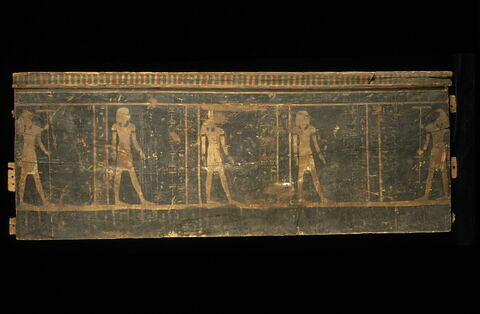Fenêtre en plein écran
Télécharger
Suivant
Précédent
Télécharger l'image
cercueil momiforme
-1427 / -1353 (milieu XVIIIe dynastie)
N 2573 ; Salt n°3006 ; 894
Département des Antiquités égyptiennes
- Numéro d’inventaire
-
Numéro principal : N 2573
N° anc. coll. : Salt n°3006
Numéro catalogue : 894 - Collection
- Département des Antiquités égyptiennes
- Dénomination / Titre
- Dénomination : cercueil momiforme
- Description / Décor
- homme (linceul, perruque tripartite, collier ousekh)
Décor : sur le couvercle ; à l'extérieur
sur le ventre ; vautour (ailes déployées, tenant, 2, signe chen)
sur la cuve ; à l'extérieur
à droite ; oeil oudjat (sur, base à corniche) ; Amset (?, debout) ; Anubis (dieu à tête de canidé, debout, bras ballants) ; Douamoutef (tête d'homme, debout, bras ballants) ; Thot (dieu à tête d'ibis, debout)
à gauche ; oeil oudjat (sur, base à corniche) ; Hapi (tête d'homme, debout, bras ballants) ; Anubis (dieu à tête de canidé, debout, bras ballants) ; Qébehsenouf (tête d'homme, debout, bras ballants) ; Thot (dieu à tête d'ibis, debout) - Inscriptions
- Écriture :
hiéroglyphique
Nature du texte :
formules funéraires - Noms et titres
- Mesrê ; les 4 fils d'Horus
- Dimensions
- Hauteur : 75 cm ; Longueur : 195 cm ; Largeur : 57 cm
- Matière et technique
-
Matériau : bois
Technique : dorure, esquisse, incrustation (yeux et sourcils autrefois incrustés), peinture, stucage
Couleur : noir-Dore - Date de création / fabrication
- milieu XVIIIe dynastie (bibliographie/travail de référence) (-1427 - -1353)
- Détenteur précédent / commanditaire / dédicataire
-
Salt, Henry, Vendeur ; Collectionneur
- Mode d’acquisition
- achat
- Date d’acquisition
- date de l'inscription sur l'inventaire : 1826
- Propriétaire
- Etat
- Affectataire
- Musée du Louvre, Département des Antiquités égyptiennes
- Emplacement actuel
-
non exposé
- Mode d'acquisition
- achat
- Dénomination
- cercueil momiforme
- Matériaux
- bois
- Technique
- esquisse - stucage - incrustation - peinture - dorure
- Description / Décor
- bras ballants - ailes déployées - Thot - signe chen - oeil oudjat - tenant - à droite - à l'extérieur - à gauche - base à corniche - sur la cuve - sur le ventre - sur le couvercle - sur - tête d'homme - homme - debout - collier ousekh - 2 - vautour - Douamoutef - Hapi - Amset - Qébehsenouf - dieu à tête d'ibis - dieu à tête de canidé - Anubis - linceul - perruque tripartite
- Noms et titres
- les 4 fils d'Horus - Mesrê
- Période
- milieu XVIIIe dynastie
- Nature du texte
- formules funéraires
- Écriture
- hiéroglyphique
-
Guerra, Maria F., « Towards a conclusion : Qurna in context », dans Guerra, Maria F. ; Martinón-Torres, Marcos ; Quirke, Stephen G. (dir.), Ancien Egyptian gold. Archaeology and science in jewellery (3500-1000 BC), Cambridge, McDoland Institute for Archaeological Research, 2023, p. 449-480, p. 470-471, fig. 11.31
-
Serpico, Margaret, « Mind the Gap : The Identification of Bitumen in Black Funerary Ritual Substances Dating to the New Kingdom », dans Lacovara, Peter (dir.), Wonderful Things: Essays in Honor of Nicholas Reeves, Columbus, Lockwood Press, 2023, p. 231-243, p. 234
-
Eschenbrenner-Diemer, Gersande ; Sartini, Lisa ; Serpico, Margaret, « Rediscovering black coffins from Deir el-Medina: a comprehensive approach », Bulletin de l'Institut Français d'Archéologie Orientale (BIFAO), 121, 2021, p. 255-305, Disponible sur : https://www.ifao.egnet.net/bifao/121/07/ , p. 262, 292, note 121
-
Sartini, Lisa, « The black coffins with yellow decoration: a typological and chronological study », Egitto e Vicino Oriente (EVO), 38, 2015, 49-66, p. 52, 55, 56, 63, n° 34
-
Andreu, Guillemette (dir.), L'Art du contour. Le dessin dans l'Égypte ancienne, cat. exp. (Paris, Musée du Louvre, 2013 ; Bruxelles, Musée Royaux d'Art et d'Histoire, 2013-2014), Paris, Louvre éditions / Somogy, 2013, p. 49, ill. p. 49, fig. 3
-
Pagès-Camagna, Sandrine ; Guichard, Hélène, « Egyptian colours and pigments in French collections: 30 years of physicochemical analyses on 300 objects », dans Rozeik, Christina ; Dawson, Julie ; Wright, Margot M. (dir.), Decorated surfaces on ancient Egyptian objects: technology, deterioration and conservation., Cambridge, Fitzwilliam Museum, University of Cambridge, 2010, p. 25-31, p. 30
-
Colinart, Sylvie, « Analysis of inorganic yellow colour in Egyptian painting », dans Davies, W. Vivian (dir.), Colour and painting in Ancient Egypt, Londres, The British Museum Press, 2001, 1-4, p. 1-2
-
Taylor, John Hilton, « Patterns of colouring on ancient Egyptian coffins from the New Kingdom to the Twenty-sixth Dynasty : an overview », dans Davies, W. Vivian (dir.), Colour and painting in Ancient Egypt, Londres, The British Museum Press, 2001, 164-181, p. 177 note 21, 178 note 34
-
Aufrère, Sydney Hervé, « Les couleurs sacrées dans l'Égypte ancienne vibration d'une lumière minérale », Technè, la science au service de l'histoire de l'art et des civilisations, 9-10, Couleur et perception, 1999, p. 19-32, p. 26, 28, Fig. 9 p. 27, Fig. 12 p. 28
-
Colinart, Sylvie ; Delange, Élisabeth, « Une polychromie complexe », Techné, 7, 1998, p 39-40, p. 39-40, Fig. 1 à 4
-
Delange, Élisabeth ; Colinart, Sylvie, « Un champ d'observations : la restauration des sarcophages au Musée du Louvre », Bulletin de la Société française d'égyptologie (BSFE), 139, 1997, p. 26-32, fig. 6-8
-
Partridge, Robert B., « Tutankhamun's gold coffin: an ancient change in design », Göttinger Miszellen (GM), 150, 1996, p. 93-98, p. 98
-
Raven, Maarten J., The tomb of Iurudef: a Memphite official in the reign of Ramesses II, Londres, Egypt Exploration Society, 1991, p. 21 n. 59, 38
-
Vandier, Jacques, Guide sommaire, [Musée du Louvre, Paris. Le département des Antiquités égyptiennes], Paris, Éditions des Musées Nationaux, 1952, p. 69
-
Vandier, Jacques, Guide sommaire, [Musée du Louvre, Paris. Le département des Antiquités égyptiennes], Paris, Éditions des Musées Nationaux, 1948, p. 68
-
Revillout, Eugène, Catalogue de sculpture égyptienne, [Musée du Louvre], Paris, Librairies-imprimeries réunies, 1889, p. 67, n° 894


